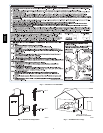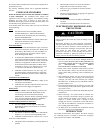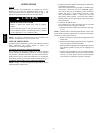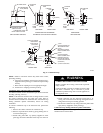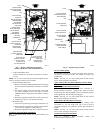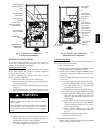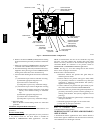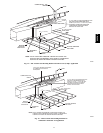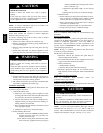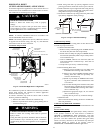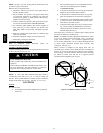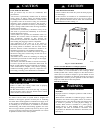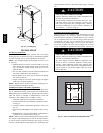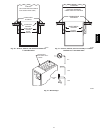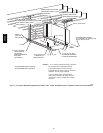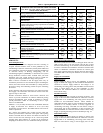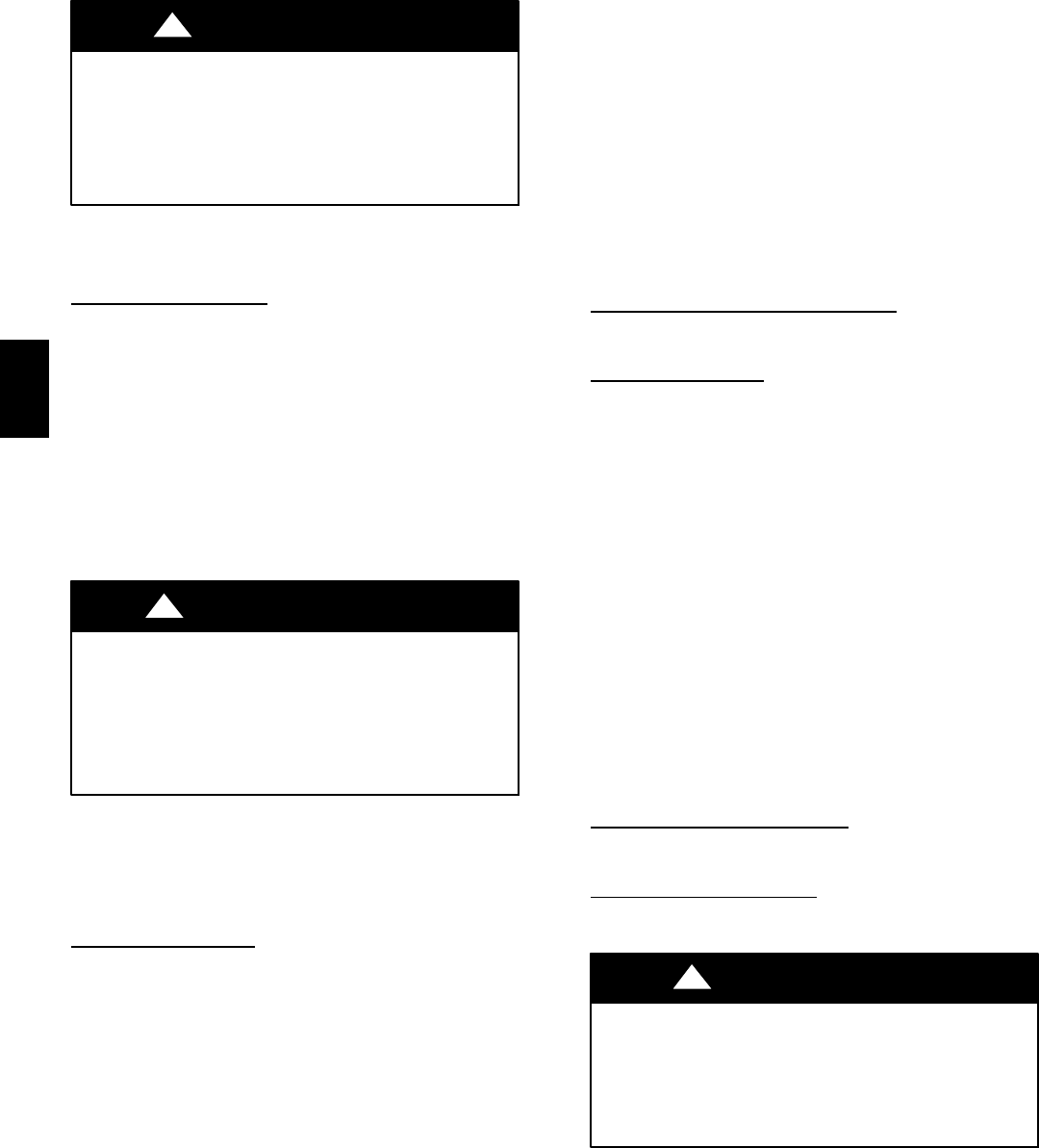
14
PROPERTY DAMAGE
Failure to follow this caution may result in property
damage.
Local codes may require a drain pan under entire furnace
and condensate trap when a condensing furnace is used in
an attic application or over a finished ceiling.
CAUTION
!
NOTE: In Canada, installations shall be in accordance with
current NSCNGPIC and/or local codes.
Condensate Trap
Location
The condensate trap must be removed from the factory --installed
blower shelf location and relocated in selected application
location as shown in Fig. 2 or 11.
To relocate condensate trap from the blower shelf to desired
location, perform the following:
1. Remove three tubes connected to condensate trap.
2. Remove trap from b lower shelf by gently pushing tabs in-
wardandrotatingtrap.
3. Remove casing hole filler cap from casing hole. (See Fig.
2or11.)
4. Install casing hole filler cap (factory--supplied in loose
parts bag) into blower shelf hole where trap was removed.
CARBON MONOXIDE POISONING HAZARD
Failure to follow this warning could result in personal
injury or death.
Casing hole filler cap must be installed in blower shelf hole
when condensate trap is relocated to prevent combustion
products being drawn in from appliances in the equipment
room.
!
WARNING
5. Install condensate trap into left--hand side casing hole by
inserting tube connection stubs through casing hole and
rotating until tabs snap into locking position.
6. Fill unused condensate trap casing holes with plastic filler
caps (factory-- supplied in loose parts bag).
Condensate Trap T
ubing
NOTE: See Fig. 11 or tube routing label on main furnace door
to check for proper connections.
1. Collector Box Drain Tube
a. Install drain tube coupling (factory-- supplied in loose
partsbag)intocollectorboxdraintube(bluelabel)which
was previously connected to condensate trap.
b. Connect large diameter drain tube and clamp (factory--
supplied in loose parts bag) to drain tube coupling, ex-
tending collector box drain tube.
c. Route extended tube (blue label) to condensate trap and
cut to appropriate length.
d. Clamp tube to prevent any condensate leakage.
2. Inducer Housing Drain Tube
(a.) Remove and d iscard LOWER (molded) inducer
housing drain tube which was previously con-
nected to condensate trap.
(b.)Use inducer housing drain extension tube (violet
label and factory--supplied in loose parts bag) to
connect LOWER inducer housing drain connec-
tion to condensate trap.
(c.)Determine appropriate length, cut and connect
tube.
(d.)Clamp tube to prevent any condensate leakage.
3. Relief Port Tube
a. Extend collector boxtube(green label)which wasprevi-
ously connected to condensate trap by splicing to small
diameter tube (factory--supplied in loose parts bag).
b. Route extended collector box pressure tube to reliefport
connection on condensate trap.
c. Determine appropriate length, cut, and connect tube.
d. Clamp tube to prevent any condensate leakage.
Condensate Trap Field Drain
Attachment
Refer to Condensate Drain section for recommendations and
procedures.
Pressure Switch T
ubing
The LOWER collector box pressure tube (pink label) is factory
connected to the High Pressure Switch for use when furnace is
installed in UPFLOW applications. This tube MUST be
disconnected, extended rerouted, and then reconnected to the
pressure switch in HORIZONTAL LEFT applications for 060
and 080 heating input furnaces.
NOTE: See Fig. 11 or tube routing label on main furnace door
to check for proper connections.
Modify tube as described below.
1. Disconnect collector box pressure tube (pink label) at-
tached to High Pressure Switch.
2. Use smaller diameter tube (factory--supplied in loose parts
bag) to extend tube disconnected in Item 1.
3. Route extended tube:
a. Behind inducer housing.
b. Between blower shelf and inducer housing.
4. Determine appropriate length, cut, and reconnect tube to
High Pressure Switch connections labeled COLLECTOR
BOX.
Condensate Trap Freeze Pr
otection
Refer to Condensate Drain Protection section for
recommendations and procedures.
Construct a Wo rking
Platform
Construct working platform where all required furnace clearances
are met. (See Fig. 3 and 12 or 13.)
UNIT OPERATION HAZARD
Failure to follow this caution may result in intermittent unit
operation.
The condensate trap MUST be installed below furnace. See
Fig. 6 for dimensions. The drain connection to condensate
trap must also be properly sloped to an open drain.
CAUTION
!
NOTE: A 12--in. (305 mm) minimum offset pipe section is
recommended with short (5 to 8 ft. or 1.5M to 2.4M) vent
systems. This recommendation is to reduce excessive condensate
droplets from exiting the vent pipe. (See Fig. 12, 13, or 44.)
355CAV



